Last stop: Voyager 2 at Triton
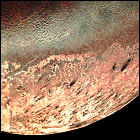 As scientists marvel over the latest data and pictures from Voyager 2 as it leaves Neptune, images of the planet’s large moon Triton prove to be jaw-dropping. Active geysers blast dark material – possibly evidence of cryovolcanism – over the moon’s mottled surface, and an atmosphere is measured. Virtually no craters caused by meteor impacts are spotted, meaning that Triton’s surface is geologically active – all completely new discoveries to Earth-based scientists. Perhaps the most frustrating part of all of the new information is that no further missions to Neptune are in serious consideration by NASA to follow up on Voyager 2’s discoveries.
As scientists marvel over the latest data and pictures from Voyager 2 as it leaves Neptune, images of the planet’s large moon Triton prove to be jaw-dropping. Active geysers blast dark material – possibly evidence of cryovolcanism – over the moon’s mottled surface, and an atmosphere is measured. Virtually no craters caused by meteor impacts are spotted, meaning that Triton’s surface is geologically active – all completely new discoveries to Earth-based scientists. Perhaps the most frustrating part of all of the new information is that no further missions to Neptune are in serious consideration by NASA to follow up on Voyager 2’s discoveries.
Voyager 2 at Neptune
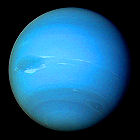 The unmanned space probe Voyager 2, almost exactly 12 years after leaving Earth, visits its last planet in the solar system, Neptune. Since mission planners have no further targets for Voyager, they have a free hand in picking its final destinations. An extremely close trajectory over Neptune’s north pole, bringing Voyager 2 within 18,000 miles of the cloudtops of the solar system’s windiest planet, deflects Voyager downward behind Neptune for a close look at its large moon, Triton. Six new moons are discovered, and the “ring arcs” that astronomers have theorized for years turn out to be complete rings made of extremely dark material. After the surprisingly featureless face of Uranus, Neptune proves to be unexpectedly active, with a large dark storm dominating its atmosphere.
The unmanned space probe Voyager 2, almost exactly 12 years after leaving Earth, visits its last planet in the solar system, Neptune. Since mission planners have no further targets for Voyager, they have a free hand in picking its final destinations. An extremely close trajectory over Neptune’s north pole, bringing Voyager 2 within 18,000 miles of the cloudtops of the solar system’s windiest planet, deflects Voyager downward behind Neptune for a close look at its large moon, Triton. Six new moons are discovered, and the “ring arcs” that astronomers have theorized for years turn out to be complete rings made of extremely dark material. After the surprisingly featureless face of Uranus, Neptune proves to be unexpectedly active, with a large dark storm dominating its atmosphere.
Voyager 2 and the ring arcs of Neptune
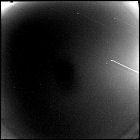 NASA announces the confirmation of what are believed to be partial rings around planet Neptune, as discovered in images taken by the unmanned Voyager 2 space probe. The ring arcs are found in close proximity to several new satellites, also spotted in Voyager 2 images, which are too small to have been seen form Earth-based telescopes. Ground-based telescopes had led scientists to believe that they would find partial rings, or complete dark rings, at Neptune; at this time, however, and at a distance of 13 million miles, what the project scientists don’t expect is that the rings will be revealed to completely encircle the planet within mere weeks.
NASA announces the confirmation of what are believed to be partial rings around planet Neptune, as discovered in images taken by the unmanned Voyager 2 space probe. The ring arcs are found in close proximity to several new satellites, also spotted in Voyager 2 images, which are too small to have been seen form Earth-based telescopes. Ground-based telescopes had led scientists to believe that they would find partial rings, or complete dark rings, at Neptune; at this time, however, and at a distance of 13 million miles, what the project scientists don’t expect is that the rings will be revealed to completely encircle the planet within mere weeks.
Voyager 2 and the lost moon of Neptune
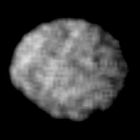 First spotted by Earth-based telescope observations in 1981, Neptune’s fourth-largest natural satellite was so tiny and dark that follow-up observations to confirm the discovery were unsuccessful…at least until Voyager 2 sights it on approach to the eighth planet, finding a tiny moon whose orbit corresponds to the theoretical orbit of the body originally sighted in 1981. In 1991, the International Astronomical Union will name this moon Larissa.
First spotted by Earth-based telescope observations in 1981, Neptune’s fourth-largest natural satellite was so tiny and dark that follow-up observations to confirm the discovery were unsuccessful…at least until Voyager 2 sights it on approach to the eighth planet, finding a tiny moon whose orbit corresponds to the theoretical orbit of the body originally sighted in 1981. In 1991, the International Astronomical Union will name this moon Larissa.
STS-30
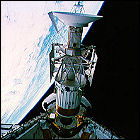 Space Shuttle Atlantis lifts off on a four-day mission to launch the long-delayed interplanetary probe Magellan, which is sent to Venus via an Interial Upper Stage booster module. For the first time, one of a shuttle’s five onboard computers fails and is replaced in an in-orbit repair procedure. Aboard Atlantis for this flight are Commander David Walker, Pilot Ronald Grabe, and mission specialists Norm Thagard, Mary Cleave and Mark Lee. The launch of Magellan, a mission originally conceived in 1972, marks the beginning of the first American interplanetary mission since 1977.
Space Shuttle Atlantis lifts off on a four-day mission to launch the long-delayed interplanetary probe Magellan, which is sent to Venus via an Interial Upper Stage booster module. For the first time, one of a shuttle’s five onboard computers fails and is replaced in an in-orbit repair procedure. Aboard Atlantis for this flight are Commander David Walker, Pilot Ronald Grabe, and mission specialists Norm Thagard, Mary Cleave and Mark Lee. The launch of Magellan, a mission originally conceived in 1972, marks the beginning of the first American interplanetary mission since 1977.
Voyager 2 and the Great Dark Spot
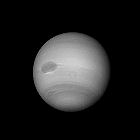 Images transmitted to Earth by NASA’s unmanned Voyager 2 spacecraft, from a distance of 129,000,000 miles, reveal a consistent feature in Neptune’s atmosphere, an oval-shaped storm system near the Neptunian equator very similar in size and position to the Great Red Spot on Jupiter. This storm, quickly nicknamed the Great Dark Spot, allows Voyager scientists to estimate Neptune’s rotational period much earlier than expected. At the distance between Voyager 2 and Neptune, the smallest features on the planet that can be seen are at least 2,400 miles across, meaning the newly detected storm system is gigantic.
Images transmitted to Earth by NASA’s unmanned Voyager 2 spacecraft, from a distance of 129,000,000 miles, reveal a consistent feature in Neptune’s atmosphere, an oval-shaped storm system near the Neptunian equator very similar in size and position to the Great Red Spot on Jupiter. This storm, quickly nicknamed the Great Dark Spot, allows Voyager scientists to estimate Neptune’s rotational period much earlier than expected. At the distance between Voyager 2 and Neptune, the smallest features on the planet that can be seen are at least 2,400 miles across, meaning the newly detected storm system is gigantic.
Phobos 2 and the curse of Mars
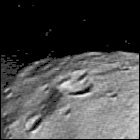 The Soviet Union loses all contact with the unmanned Mars probe Phobos 2 during a close flyby of the inner Martian moon Phobos, where the vehicle had been programmed to deposit a pair of surface landers. Unable to reacquire communications with Phobos 2, Soviet ground controllers later discover a fatal error in the programming of the probe’s on-board computer, leading to a loss of attitude control similar to the incident that doomed Phobos 1 in 1988. Since delivery of the landers never occurs, the mission is deemed a failure.
The Soviet Union loses all contact with the unmanned Mars probe Phobos 2 during a close flyby of the inner Martian moon Phobos, where the vehicle had been programmed to deposit a pair of surface landers. Unable to reacquire communications with Phobos 2, Soviet ground controllers later discover a fatal error in the programming of the probe’s on-board computer, leading to a loss of attitude control similar to the incident that doomed Phobos 1 in 1988. Since delivery of the landers never occurs, the mission is deemed a failure.
Phobos 2 arrives at Mars
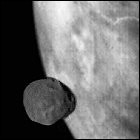 The Soviet Union’s unmanned Mars probe Phobos 2 successfully arrives in orbit around the red planet after over half a year of interplanetary travel (and after the loss of its identical twin, Phobos 1). Phobos 2 begins taking pictures of both Mars and Phobos and begins a series of orbital maneuvers that will eventually lead it to a very close approach to Phobos, where it is expected to release a pair of surface landers, the first of their kind to study a Martian moon.
The Soviet Union’s unmanned Mars probe Phobos 2 successfully arrives in orbit around the red planet after over half a year of interplanetary travel (and after the loss of its identical twin, Phobos 1). Phobos 2 begins taking pictures of both Mars and Phobos and begins a series of orbital maneuvers that will eventually lead it to a very close approach to Phobos, where it is expected to release a pair of surface landers, the first of their kind to study a Martian moon.
Voyager 2 and the clouds of Neptune
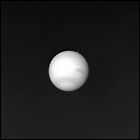 For the first time, images transmitted to Earth by NASA’s unmanned Voyager 2 space probe reveal visible cloud features in the atmosphere of Neptune, from a distance of 185,000,000 miles. This is a welcome relief to mission scientists who felt let down by a lamentable lack of any atmospheric detail in the clouds of Uranus, a planet visited by Voyager 2 in 1986. In the months ahead, even more detail will be revealed in Neptune’s upper atmosphere.
For the first time, images transmitted to Earth by NASA’s unmanned Voyager 2 space probe reveal visible cloud features in the atmosphere of Neptune, from a distance of 185,000,000 miles. This is a welcome relief to mission scientists who felt let down by a lamentable lack of any atmospheric detail in the clouds of Uranus, a planet visited by Voyager 2 in 1986. In the months ahead, even more detail will be revealed in Neptune’s upper atmosphere.
Phobos 1 and the curse of Mars
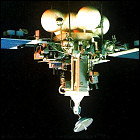 The Soviet Union loses contact with the Phobos 1 unmanned Mars probe during its interplanetary flight and is unable to re-establish contact. The cause of the vehicle’s loss is later traced to a typo in a single line of command code uplinked to its computer from the ground; this error changes a routine command to a command to shut down attitude control, leaving Phobos 1 tumbling through space, unable to point its antenna toward Earth. The mission is a complete loss.
The Soviet Union loses contact with the Phobos 1 unmanned Mars probe during its interplanetary flight and is unable to re-establish contact. The cause of the vehicle’s loss is later traced to a typo in a single line of command code uplinked to its computer from the ground; this error changes a routine command to a command to shut down attitude control, leaving Phobos 1 tumbling through space, unable to point its antenna toward Earth. The mission is a complete loss.
Voyager 2 and the eight pixels
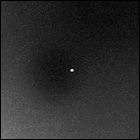 From within 500 million miles, cameras aboard NASA’s Voyager 2 unmanned space probe can now get a better look at planet Neptune than is possible with ground-based telescopes on Earth – even though, at present, that means a tiny disk only eight pixels across in images measuring 800 x 800 pixels. Voyager 2 is still over a year away from its closest encounter with Neptune, and even its own best photos don’t reveal any detail in the blue-green planet’s atmosphere. What is known is that, despite receiving less than half the sunlight and heat of the next innermost planet, Uranus, Neptune maintains the same temperature as Uranus. This means that Neptune is generating more heat than it receives from the sun.
From within 500 million miles, cameras aboard NASA’s Voyager 2 unmanned space probe can now get a better look at planet Neptune than is possible with ground-based telescopes on Earth – even though, at present, that means a tiny disk only eight pixels across in images measuring 800 x 800 pixels. Voyager 2 is still over a year away from its closest encounter with Neptune, and even its own best photos don’t reveal any detail in the blue-green planet’s atmosphere. What is known is that, despite receiving less than half the sunlight and heat of the next innermost planet, Uranus, Neptune maintains the same temperature as Uranus. This means that Neptune is generating more heat than it receives from the sun.
Phobos 2 launched
 The Soviet Union launches the second of two unmanned Phobos space probes, designed to investigate the largest of Mars’ two asteroid-like moons and deliver a lander to analyze that moon’s surface. The Phobos program is intended to be the definitive Mars exploration program of the 1980s, as well as the debut of a new Soviet interplanetary vehicle to take over from the Zond/Venera design in use since the 1960s; only Phobos 2 will actually reach its target intact, but it will still fail to complete all of its mission objectives.
The Soviet Union launches the second of two unmanned Phobos space probes, designed to investigate the largest of Mars’ two asteroid-like moons and deliver a lander to analyze that moon’s surface. The Phobos program is intended to be the definitive Mars exploration program of the 1980s, as well as the debut of a new Soviet interplanetary vehicle to take over from the Zond/Venera design in use since the 1960s; only Phobos 2 will actually reach its target intact, but it will still fail to complete all of its mission objectives.
Phobos 1 launched
 The Soviet Union launches the first of two unmanned Phobos space probes, designed to investigate the largest of Mars’ two asteroid-like moons and deliver a lander to analyze that moon’s surface. With multiple nations pitching in resources to help the mission succeed, including the United States, the Phobos program is intended to be the definitive Mars exploration program of the 1980s, as well as the debut of a new Soviet interplanetary vehicle to take over from the Zond/Venera design in use since the 1960s.
The Soviet Union launches the first of two unmanned Phobos space probes, designed to investigate the largest of Mars’ two asteroid-like moons and deliver a lander to analyze that moon’s surface. With multiple nations pitching in resources to help the mission succeed, including the United States, the Phobos program is intended to be the definitive Mars exploration program of the 1980s, as well as the debut of a new Soviet interplanetary vehicle to take over from the Zond/Venera design in use since the 1960s.
Mocking up Magellan
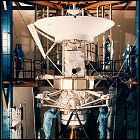 NASA has to borrow some of its own spare parts back from the Smithsonian Air & Space Museum to begin engineering mock-up work on the unmanned Venus radar mapping probe Magellan. As JPL works on modifications to a backup central bus component left over from the Voyager program, a physical copy of that bus from an engineering backup of the Voyager spacecraft is loaned back to JPL, shipped to Pasadena from Washington, D.C. (This loan saves JPL the trouble of building another replica of the bus, the central hub of the spacecraft containing its computer and electrical systems, which could add significant cost to the preparations.) The real Magellan, due to be launched soon after the currently grounded space shuttle program resumes, will cut costs by incorporating unused backup equipment from its predecessors, including a Voyager central bus and high-gain antenna, a medium-gain antenna spare from the Mariner missions to Mars, and a Galileo data handling system.
NASA has to borrow some of its own spare parts back from the Smithsonian Air & Space Museum to begin engineering mock-up work on the unmanned Venus radar mapping probe Magellan. As JPL works on modifications to a backup central bus component left over from the Voyager program, a physical copy of that bus from an engineering backup of the Voyager spacecraft is loaned back to JPL, shipped to Pasadena from Washington, D.C. (This loan saves JPL the trouble of building another replica of the bus, the central hub of the spacecraft containing its computer and electrical systems, which could add significant cost to the preparations.) The real Magellan, due to be launched soon after the currently grounded space shuttle program resumes, will cut costs by incorporating unused backup equipment from its predecessors, including a Voyager central bus and high-gain antenna, a medium-gain antenna spare from the Mariner missions to Mars, and a Galileo data handling system.
Pioneer Venus eyes Comet Wilson
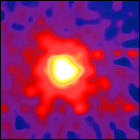 A victory lap after its successful study of Halley’s Comet in 1985 and 1986, the Pioneer Venus Orbiter uses its unique position at the solar system’s second planet to observe another comet, the recently-discovered Comet Wilson. Spotted for the first time only the year before, little is known about Comet Wilson, a lack of data that Pioneer Venus helps to correct by imaging the comet in the ultraviolet portion of the spectrum. Pioneer Venus will also study two other comets later in 1987.
A victory lap after its successful study of Halley’s Comet in 1985 and 1986, the Pioneer Venus Orbiter uses its unique position at the solar system’s second planet to observe another comet, the recently-discovered Comet Wilson. Spotted for the first time only the year before, little is known about Comet Wilson, a lack of data that Pioneer Venus helps to correct by imaging the comet in the ultraviolet portion of the spectrum. Pioneer Venus will also study two other comets later in 1987.
GOES-7 goes up
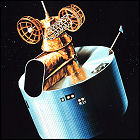 NOAA’s GOES-7 Geostationary Operational Environmental Satellite is launched from Cape Canaveral into a geosynchronous orbit now designated GOES-EAST to monitor weather patterns over the United States. Originally intended for a 1986 launch, GOES-7 has been kept on the ground by the investigation into the destruction just after launch of its predecessor, GOES-G. GOES-7 will become the first of the GOES satellites to operate in both the GOES-EAST and GOES-WEST orbits, and will be retired from active weather-watching duty in 1999, becoming a communications relay satellite until it is decommissioned in 2012.
NOAA’s GOES-7 Geostationary Operational Environmental Satellite is launched from Cape Canaveral into a geosynchronous orbit now designated GOES-EAST to monitor weather patterns over the United States. Originally intended for a 1986 launch, GOES-7 has been kept on the ground by the investigation into the destruction just after launch of its predecessor, GOES-G. GOES-7 will become the first of the GOES satellites to operate in both the GOES-EAST and GOES-WEST orbits, and will be retired from active weather-watching duty in 1999, becoming a communications relay satellite until it is decommissioned in 2012.
Galileo is go for VEEGA
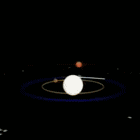 After the cancellation of the Centaur liquid-fueled propulsion module – considered too risky for use aboard the space shuttle, all aspects of which are now under a wide-ranging government review after the Challenger disaster – NASA/JPL’s Galileo Jupiter probe is to begin undergoing modifications for a long, looping trajectory developed by Dr. Roger Diehl and dubbed “VEEGA” – Venus/Earth/Earth Gravity Assist. (Another nickname for this new trajectory, the Solar Cruiser, doesn’t stick in acronym-happy NASA.) VEEGA will see Galileo taking an extra four years to reach Jupiter, getting gravity assists from the planets of the inner solar system during those additional years. Galileo must be modified because it was designed for outer solar system exploration, not exposure to solar heating and radiation within 1 AU of the sun. Since the primary high-gain antenna must be pointed away from Earth during some of this flight, NASA adds a medium-gain antenna to the spacecraft – a last-minute modification which will save the mission when the high-gain antenna fails to open on schedule. Galileo is scheduled for launch via space shuttle in 1989.
After the cancellation of the Centaur liquid-fueled propulsion module – considered too risky for use aboard the space shuttle, all aspects of which are now under a wide-ranging government review after the Challenger disaster – NASA/JPL’s Galileo Jupiter probe is to begin undergoing modifications for a long, looping trajectory developed by Dr. Roger Diehl and dubbed “VEEGA” – Venus/Earth/Earth Gravity Assist. (Another nickname for this new trajectory, the Solar Cruiser, doesn’t stick in acronym-happy NASA.) VEEGA will see Galileo taking an extra four years to reach Jupiter, getting gravity assists from the planets of the inner solar system during those additional years. Galileo must be modified because it was designed for outer solar system exploration, not exposure to solar heating and radiation within 1 AU of the sun. Since the primary high-gain antenna must be pointed away from Earth during some of this flight, NASA adds a medium-gain antenna to the spacecraft – a last-minute modification which will save the mission when the high-gain antenna fails to open on schedule. Galileo is scheduled for launch via space shuttle in 1989.
GOES-G goes nowhere fast
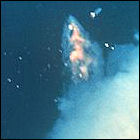 NOAA’s GOES-G Geostationary Operational Environmental Satellite is launched from Cape Canaveral, intended to replace the failed GOES-5 satellite in a geosynchronous orbit over Earth’s western hemisphere. But an electrical fault destroys GOES-G’s Delta booster in flight, and the rocket explodes 71 seconds into its flight. This is NASA’s first attempt to launch a rocket since the Space Shuttle Challenger disaster earlier in 1986, raising new questions about the space agency’s reliability and safety record.
NOAA’s GOES-G Geostationary Operational Environmental Satellite is launched from Cape Canaveral, intended to replace the failed GOES-5 satellite in a geosynchronous orbit over Earth’s western hemisphere. But an electrical fault destroys GOES-G’s Delta booster in flight, and the rocket explodes 71 seconds into its flight. This is NASA’s first attempt to launch a rocket since the Space Shuttle Challenger disaster earlier in 1986, raising new questions about the space agency’s reliability and safety record.
Giotto gets close to Halley’s Comet
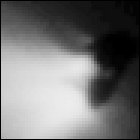 The European Space Agency’s unmanned Giotto space probe makes its closest approach to the nucleus of Halley’s Comet, coming within 400 miles of the comet’s core and taking unprecedented photos that help scientists refine their theories about cometary composition and formation. Giotto pays for the close encounter by taking a beating: its instruments register significant dust impacts, and one impact event jars the spacecraft off of its axis, coming dangerously close to breaking Giotto’s radio contact with Earth and forcing the vehicle to stabilize itself with thrusters. After its encounter with the comet, Giotto falls into a long, looping orbit around Earth, where it will be reactivated to study another comet years later.
The European Space Agency’s unmanned Giotto space probe makes its closest approach to the nucleus of Halley’s Comet, coming within 400 miles of the comet’s core and taking unprecedented photos that help scientists refine their theories about cometary composition and formation. Giotto pays for the close encounter by taking a beating: its instruments register significant dust impacts, and one impact event jars the spacecraft off of its axis, coming dangerously close to breaking Giotto’s radio contact with Earth and forcing the vehicle to stabilize itself with thrusters. After its encounter with the comet, Giotto falls into a long, looping orbit around Earth, where it will be reactivated to study another comet years later.
Vega 2 visits Halley
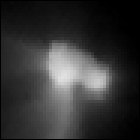 The Soviet Union’s unmanned space probe Vega 2 makes its closest approach to the nucleus of Halley’s Comet, within 5,000 miles of the comet’s icy core. Hundreds of photos are taken and transmitted back to Earth, along with analysis of the dust and gas surrounding the comet. Within a week, Vega 2’s mission is complete, and the probe is allowed to fall into an orbit around the sun as Halley continues to speed back toward the outer solar system.
The Soviet Union’s unmanned space probe Vega 2 makes its closest approach to the nucleus of Halley’s Comet, within 5,000 miles of the comet’s icy core. Hundreds of photos are taken and transmitted back to Earth, along with analysis of the dust and gas surrounding the comet. Within a week, Vega 2’s mission is complete, and the probe is allowed to fall into an orbit around the sun as Halley continues to speed back toward the outer solar system.
Vega 1 visits Halley
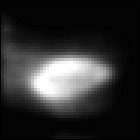 The Soviet Union’s unmanned space probe Vega 1 makes its closest approach to the nucleus of Halley’s Comet, a little over 5,000 miles away (a closer flight path is taken by its twin, Vega 2). Information gathered in the earliest stages of the encounter is shared with the European Space Agency, whose Giotto unmanned probe will make a much closer examination of Halley. Vega 1 registers an immense number of impacts from dust particles, but sustains no serious damage in close proximity to the comet; after several days of observations, Vega 1 is allowed to fall into an orbit around the sun.
The Soviet Union’s unmanned space probe Vega 1 makes its closest approach to the nucleus of Halley’s Comet, a little over 5,000 miles away (a closer flight path is taken by its twin, Vega 2). Information gathered in the earliest stages of the encounter is shared with the European Space Agency, whose Giotto unmanned probe will make a much closer examination of Halley. Vega 1 registers an immense number of impacts from dust particles, but sustains no serious damage in close proximity to the comet; after several days of observations, Vega 1 is allowed to fall into an orbit around the sun.
Galileo, Magellan go back to the shop
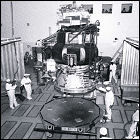 NASA informs the project managers of the Galileo and Magellan interplanetary probes – both of which were due to be launched via space shuttle – that their planned launches are obviously off the schedule due to the destruction of space shuttle Challenger and her crew. Further changes in the shuttle program in the wake of the tragedy will have far-reaching effects, including the cancellation of propulsion modules that would have allowed, for example, Galileo to be put on a direct trajectory toward Jupiter. The Galileo mission plan will undergo significant changes, including the loss of a planned visit to asteroid 29 Amphitrite, and both missions will eventually begin from the cargo bay of space shuttle missions in 1989.
NASA informs the project managers of the Galileo and Magellan interplanetary probes – both of which were due to be launched via space shuttle – that their planned launches are obviously off the schedule due to the destruction of space shuttle Challenger and her crew. Further changes in the shuttle program in the wake of the tragedy will have far-reaching effects, including the cancellation of propulsion modules that would have allowed, for example, Galileo to be put on a direct trajectory toward Jupiter. The Galileo mission plan will undergo significant changes, including the loss of a planned visit to asteroid 29 Amphitrite, and both missions will eventually begin from the cargo bay of space shuttle missions in 1989.
Voyager 2 at Uranus
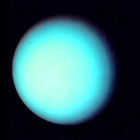 Voyager 2 visits the third planet on its grand tour of the outer solar system, becoming the first and only man-made spacecraft to visit Uranus. Since the blue-green planet and its moon are tipped over, Voyager has fewer opportunities to gather images of the moons of Uranus, but a close pass by its innermost large satellite, Miranda, yields pictures of one of the stranger surfaces in the solar system: a moon that was ripped apart and melted back together in the distant past. The atmosphere of Uranus reveals almost no details to Voyager 2’s cameras in the scant visible light available this far from the sun, but ten new moons are discovered, and the planet’s elusive dark rings are captured in several images. With no other missions to Uranus in the pipeline, Voyager 2’s brief flyby remains the primary source of most of our knowledge of the seventh planet from the sun. It will now take Voyager 2 three years to reach Neptune, its final target.
Voyager 2 visits the third planet on its grand tour of the outer solar system, becoming the first and only man-made spacecraft to visit Uranus. Since the blue-green planet and its moon are tipped over, Voyager has fewer opportunities to gather images of the moons of Uranus, but a close pass by its innermost large satellite, Miranda, yields pictures of one of the stranger surfaces in the solar system: a moon that was ripped apart and melted back together in the distant past. The atmosphere of Uranus reveals almost no details to Voyager 2’s cameras in the scant visible light available this far from the sun, but ten new moons are discovered, and the planet’s elusive dark rings are captured in several images. With no other missions to Uranus in the pipeline, Voyager 2’s brief flyby remains the primary source of most of our knowledge of the seventh planet from the sun. It will now take Voyager 2 three years to reach Neptune, its final target.
Pioneer Venus captures Halley’s Comet
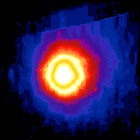 Having already conducted measuresment of Comets Encke and Giacobini-Zinner, the still-functioning Pioneer Venus Orbiter, launched in 1978, becomes the centerpiece of the American effort to gather close-up data on Halley’s Comet. Imaging the comet in ultraviolet light, Pioneer Venus captures Halley from a unique vantage point: both the comet and the planet being orbited by Pioneer are on the opposite side of the sun from Earth, when Halley is at its closest approach to the sun – an event that no other spacecraft is in a position to witness. The Pioneer Venus data will become the most critical data gathered on Halley by an American spacecraft after a planned March 1986 Space Shuttle mission to image the comet from Earth orbit is scrapped in the wake of the Challenger disaster in January.
Having already conducted measuresment of Comets Encke and Giacobini-Zinner, the still-functioning Pioneer Venus Orbiter, launched in 1978, becomes the centerpiece of the American effort to gather close-up data on Halley’s Comet. Imaging the comet in ultraviolet light, Pioneer Venus captures Halley from a unique vantage point: both the comet and the planet being orbited by Pioneer are on the opposite side of the sun from Earth, when Halley is at its closest approach to the sun – an event that no other spacecraft is in a position to witness. The Pioneer Venus data will become the most critical data gathered on Halley by an American spacecraft after a planned March 1986 Space Shuttle mission to image the comet from Earth orbit is scrapped in the wake of the Challenger disaster in January.
Comet Giacobini-Zinner gets ICEd
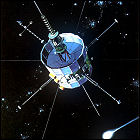 The International Cometary Explorer satellite – originally launched as International Sun-Earth Explorer 3 in 1978 – reaches the culmination of a series of complex orbital changes: a flyby of Comet Giacobini-Zinner, within 5,000 miles of the nucleus, primarily to sample and study the comet’s plasma tail and the interaction between that and the solar wind. ISEE-3 was not equipped with cameras at launch, so no imagery of the comet is obtained. The success of this flyby emboldens mission planners who hope to send it onward to study Halley’s Comet early in 1986, as part of a backup plan to use existing NASA spacecraft to study Halley in lieu of a specialized vehicle that would’ve been launched by space shuttle in 1986 (cancelled in the wake of the Challenger disaster).
The International Cometary Explorer satellite – originally launched as International Sun-Earth Explorer 3 in 1978 – reaches the culmination of a series of complex orbital changes: a flyby of Comet Giacobini-Zinner, within 5,000 miles of the nucleus, primarily to sample and study the comet’s plasma tail and the interaction between that and the solar wind. ISEE-3 was not equipped with cameras at launch, so no imagery of the comet is obtained. The success of this flyby emboldens mission planners who hope to send it onward to study Halley’s Comet early in 1986, as part of a backup plan to use existing NASA spacecraft to study Halley in lieu of a specialized vehicle that would’ve been launched by space shuttle in 1986 (cancelled in the wake of the Challenger disaster).
Giotto comet chaser launched
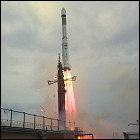 The European Space Agency launches the unmanned Giotto space probe, designed to rendezvous with and observe Halley’s Comet during the comet’s pass through the inner solar system in 1986. The first-ever ESA mission aiming for a target beyond Earth orbit, Giotto is based loosely on the design of ESA’s GEOS satellites, with thick aluminum and Kevlar shielding to help the probe survive potential impacts with cometary matter as it closes in on Halley’s nucleus. Giotto is the first spacecraft ever to use Earth itself for a gravity assist maneuver (which later becomes standard practice with such space vehicles as Galileo, Messenger and Juno). It will go on to become the first vehicle to visit a comet.
The European Space Agency launches the unmanned Giotto space probe, designed to rendezvous with and observe Halley’s Comet during the comet’s pass through the inner solar system in 1986. The first-ever ESA mission aiming for a target beyond Earth orbit, Giotto is based loosely on the design of ESA’s GEOS satellites, with thick aluminum and Kevlar shielding to help the probe survive potential impacts with cometary matter as it closes in on Halley’s nucleus. Giotto is the first spacecraft ever to use Earth itself for a gravity assist maneuver (which later becomes standard practice with such space vehicles as Galileo, Messenger and Juno). It will go on to become the first vehicle to visit a comet.
Vega 2 visits Venus
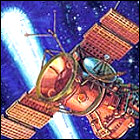 The landing module of the Vega 2 unmanned space probe successfully lands on Venus, gathering and analyzing soil samples and transmitting its findings back to Earth before the heat and atmospheric pressure destroy it within an hour. The terrain it lands on is found to be composed of rock resembling the surface of Earth’s moon. The Vega 2 “mothership” continues past Venus, en route to a rendezvous with Halley’s Comet.
The landing module of the Vega 2 unmanned space probe successfully lands on Venus, gathering and analyzing soil samples and transmitting its findings back to Earth before the heat and atmospheric pressure destroy it within an hour. The terrain it lands on is found to be composed of rock resembling the surface of Earth’s moon. The Vega 2 “mothership” continues past Venus, en route to a rendezvous with Halley’s Comet.
Vega 1 visits Venus
 The landing module of the Vega 1 unmanned space probe arrives at the planet Venus, though some of its on-board experiment packages activate during descent, rather than activating after contact with the surface, and little data is returned. Thanks to a gravity assist from a close flyby of Venus, the Vega 1 “mothership” continues past the planet toward a 1986 rendezvous with Halley’s Comet.
The landing module of the Vega 1 unmanned space probe arrives at the planet Venus, though some of its on-board experiment packages activate during descent, rather than activating after contact with the surface, and little data is returned. Thanks to a gravity assist from a close flyby of Venus, the Vega 1 “mothership” continues past the planet toward a 1986 rendezvous with Halley’s Comet.
Voyager 2: reloaded
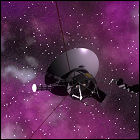 NASA engineers complete a multi-year project to completely reprogram Voyager 2 during the unmanned space probe’s five-year journey from Saturn to Uranus. A planet receiving only a fraction of the sunlight that made photography possible at Jupiter and Saturn, Uranus requires much longer exposures, slower camera shutter speeds, and incredibly precise camera tracking. To compensate for the extreme lag in comunications to and from Uranus, data compression algorithms are devised using techniques that simply didn’t exist at the time of Voyager 2’s construction and original programming, but the compression scheme is an all-or-nothing proposition: it ties up Voyager 2’s backup computer, meaning that a failure of the main computer during a critical maneuver could send the probe off-course, perhaps even colliding with the bodies it intends to study.
NASA engineers complete a multi-year project to completely reprogram Voyager 2 during the unmanned space probe’s five-year journey from Saturn to Uranus. A planet receiving only a fraction of the sunlight that made photography possible at Jupiter and Saturn, Uranus requires much longer exposures, slower camera shutter speeds, and incredibly precise camera tracking. To compensate for the extreme lag in comunications to and from Uranus, data compression algorithms are devised using techniques that simply didn’t exist at the time of Voyager 2’s construction and original programming, but the compression scheme is an all-or-nothing proposition: it ties up Voyager 2’s backup computer, meaning that a failure of the main computer during a critical maneuver could send the probe off-course, perhaps even colliding with the bodies it intends to study.
Vega 2 launched
 Just days after its twin lifts off, the unmanned Vega 2 space probe is launched by the Soviet Union on a dual mission to drop off a lander at Venus and then to intercept Halley’s Comet in 1986. Derived from the USSR’s earlier Venera Venus landers, Vega 2 will test a refined landing system for landing on Venus by balloon, and will then join an international fleet of unmanned spacecraft attempting to take advantage of Halley’s visit to the inner solar system in late 1985 and early 1986.
Just days after its twin lifts off, the unmanned Vega 2 space probe is launched by the Soviet Union on a dual mission to drop off a lander at Venus and then to intercept Halley’s Comet in 1986. Derived from the USSR’s earlier Venera Venus landers, Vega 2 will test a refined landing system for landing on Venus by balloon, and will then join an international fleet of unmanned spacecraft attempting to take advantage of Halley’s visit to the inner solar system in late 1985 and early 1986.